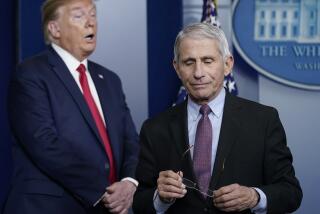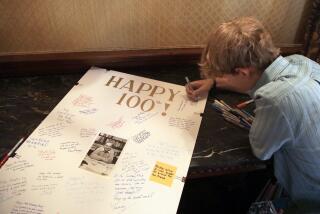Superscientist Balances Home Life and Lab Life
- Share via
When Caltech scientist Leroy Hood announced last month the development of a new DNA sequencer, a machine that was heralded as a major breakthrough in genetic research, he had only one problem: The press conference was supposed to be in Washington, but it was honors day for his two children at Polytechnic High School in Pasadena.
So he did the only sensible thing. He moved the press conference to Pasadena and went to honors day too.
Which event had more impact on the lives of the Hood family is hard to say; wife Valerie put things in perspective when she said: “It’s exciting to share in something that is national news, but you have to realize that there is something exciting happening in Lee’s life every day.”
A Noted Biologist
Lee Hood, 47, is considered one of the foremost biologists in the country, and the lab he heads at Caltech is known among scientists as the one not to be in competition with.
He holds an MD and is chairman of Caltech’s division of biology. Last year he was named California Scientist of the Year by the National Academy of Science for his work on the human immune system.
The DNA sequencer, which Hood still considers to be the “Model T” version of what will be a “Cadillac” in a few years, “reads” DNA molecules hundreds of times faster than was ever possible, paving the way for more detailed genetic research.
But Lee Hood in the biology lab is a different man from Lee Hood at home; when he walks in the front door he is neither superscientist nor superdad, just dad. In the spacious Spanish-style house that is a calculator’s throw from Caltech, work is rarely discussed (his decision), and even when it is, it doesn’t have much priority.
“Everyone asks me, ‘What does your father do?’ ” said Marqui, 16. She answers the question with a shrug. It’s a humbling thought.
An Accomplished Family
His work has had enormous impact on the family, but others’ accomplishments hardly go unnoticed. Valerie, 47, also works at the university as associate director of the Industrial Relations Center, working with corporations’ management programs. Before that she ran a factory, conducted assertiveness training classes and taught English. Their son Eran, 18, is headed for Harvard next year, and Marqui will be a junior at Polytechnic, a private high school in Pasadena.
Living in an academic/scientific environment has meant some adjustments. Lee worked too late in the lab many nights to tuck the kids in bed; international conferences meant trips to Greece, Germany and China, making them world travelers early on.
“I think Lee was never here for a parent open house,” Valerie recalled. “There are lots of things like that I’ve gone to alone. But on the other hand we have had these incredible opportunities that we wouldn’t have had in a more ‘normal’ life style. I think we realize these (trips) are all very special, rare things.”
There seem to be few regrets from Lee, who said, “Life is a series of trade-offs. You have to decide what your priorities are. We have not a spectacular but a quite reasonable family life. We’ve raised two kids who are wonderful people, productive individuals, and it’s worked out quite well. But once you get into doing something you really like, it’s hard to stop. I don’t view my job as a job. It’s what I spend most of my time doing.”
No Celebrity at Home
When a new development from the Hood lab makes news, Lee is still not treated as a celebrity. Said Eran: “It’s not something my friends pay attention to, international science. They’ll see his picture in the paper, but it’s not like he’s a famous athlete.”
Marqui agreed. “We see him when he wakes up in the morning, so we know he’s not the supergod that articles make him out to be sometimes. My friends will notice his picture in the paper, but they won’t read the article.”
Lee Hood maintains he has no burning desire to see his children follow in his footsteps, although Eran says he’s toying with the idea of majoring in biology.
Still, there have been subtle influences on the Hood children. For instance, through the years their home has been open to visiting scientists and students from around the world. It’s not unusual to come downstairs in the morning and stumble into a stranger happily munching away at breakfast.
And if nothing else, Lee and Valerie Hoods’ drive and ambition is something they have taught by example. “I think they should do something challenging,” Lee said, “but I think it should be something they want to do, something that’s creative and productive, whatever it is.”
“That’s actually a very strong message in this family,” Valerie added. “If you’re going to do something, do it passionately.”
That edict doesn’t appear to have intimidated the children. Eran was named athlete of the year, as well as outstanding math and science student. Marqui is active on the swim and soccer teams, is a peer counselor for Planned Parenthood and is involved with other community-service work.
There is a parallel between the way Lee runs his laboratory and how he and his wife have reared their children: The possibilities are limitless for exploring new ideas, but that also means taking on greater responsibility.
Lee acknowledges his responsibility to educate the public about the ramifications of scientific developments. “I think what science does,” he said, “is provide the tools that will allow man to do many different jobs more easily. The tools themselves don’t have any relationship to ethics, it’s how the tools get used. And as a scientist and concerned citizen you have to be worried about the moral and ethical issues. But those issues are bigger than scientists, they are decided by all phases of society. And one of the problems the biologist has is getting some of the branches of society interested in these emerging problems.”
He cited as an example the long-range effects of the DNA sequencer. “Is it going to be good with the machines we have now to be able to fingerprint all the human genes that we know about? I guess that in five years we may be able to fingerprint 500 different genes that cause human diseases. So that means you could go into the unborn fetus and determine whether the fetus has a bad gene. Now is that good or is that bad? In my view that’s good. The more knowledge we have the better off we are. But the whole question of who makes those decisions is the problem of society.”
He has lectured on this subject at community churches and international science conferences, and to a certain extent he feels he has reached people. “I think I’ve made a difference at the level of individuals in that they’re better educated. But none of us has been very successful in getting together a national forum. I suspect what’s going to end up happening is that it’s really going to get to the day of some of these major decisions and all of a sudden there will be a hue and a cry and someone will say we’ll have to get more people involved.”
‘Public-Health Problem’
“I think you’re there right now with AIDS,” Valerie said. “It’s a staggering public-health problem. There has been so much misinformation, people thinking that it only affects certain segments of society.”
And when the subject of his accomplishments comes up again, Lee is quick not to take full responsibility. “I felt an enormous sense of pride (when the announcement about the DNA sequencer was made). But the thing you have to understand is that most of the people who have done the hard work are the post-doctoral fellows and the graduate students. What I’ve done is create an environment and outlined the kinds of problems we’re going to deal with. But it does make you feel really proud to be associated with a place that can do that kind of thing.”






